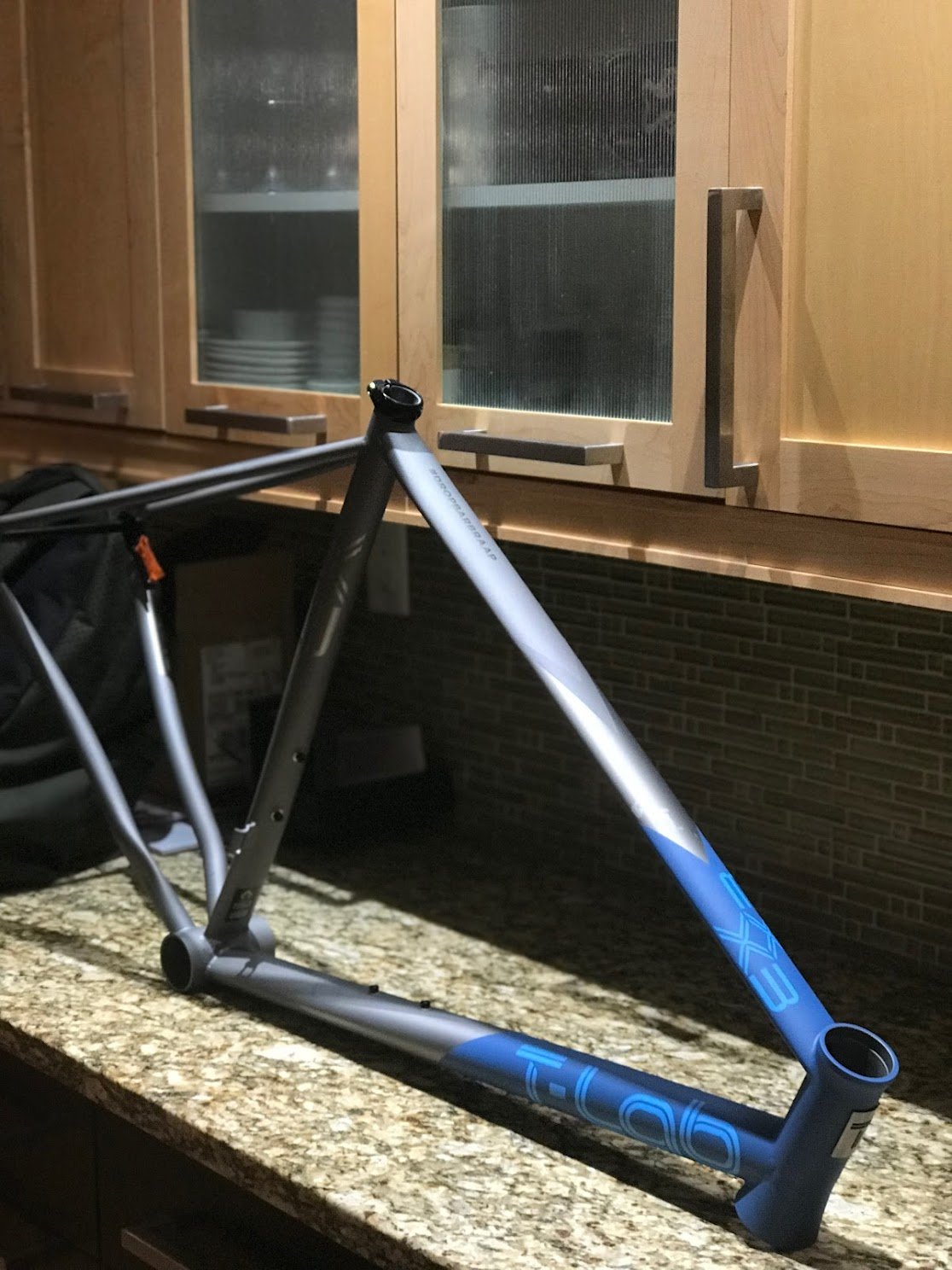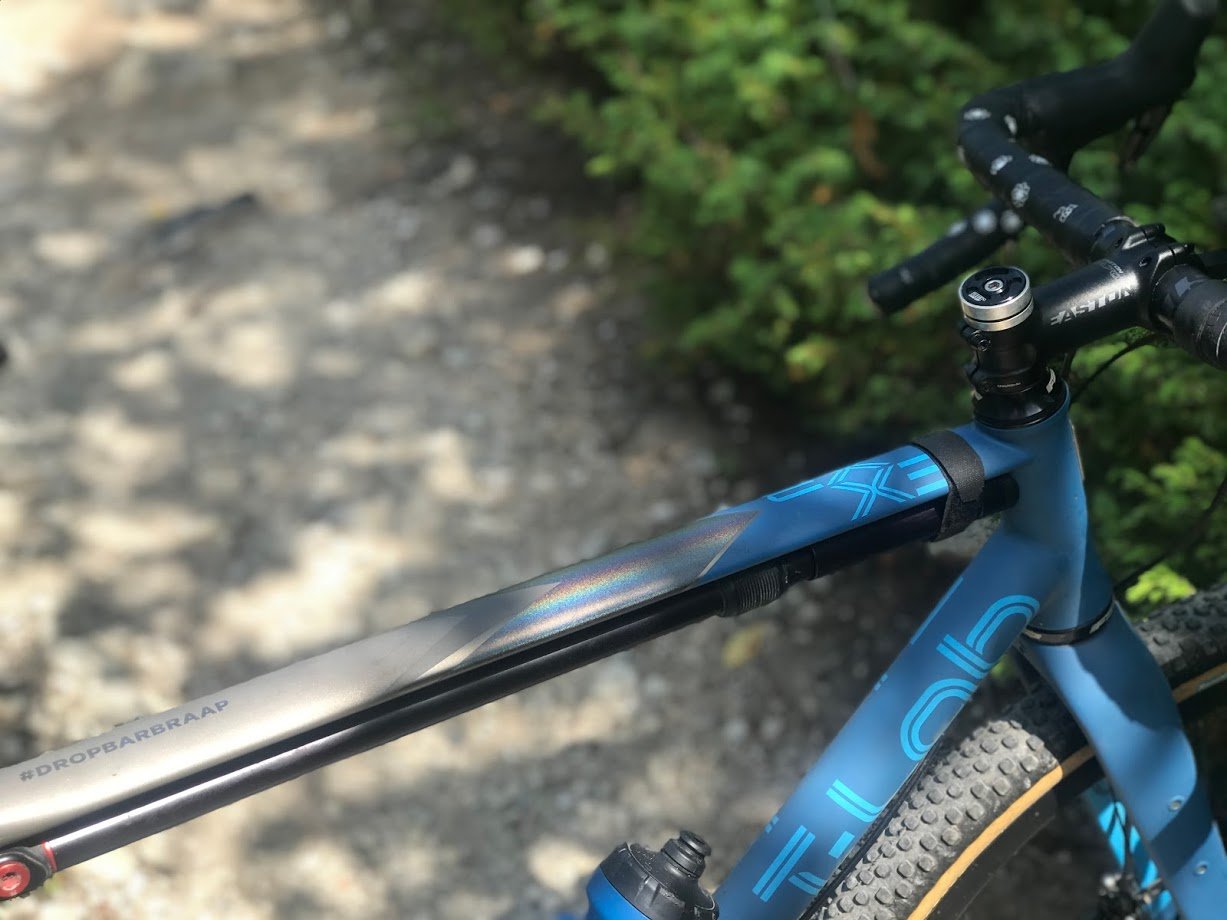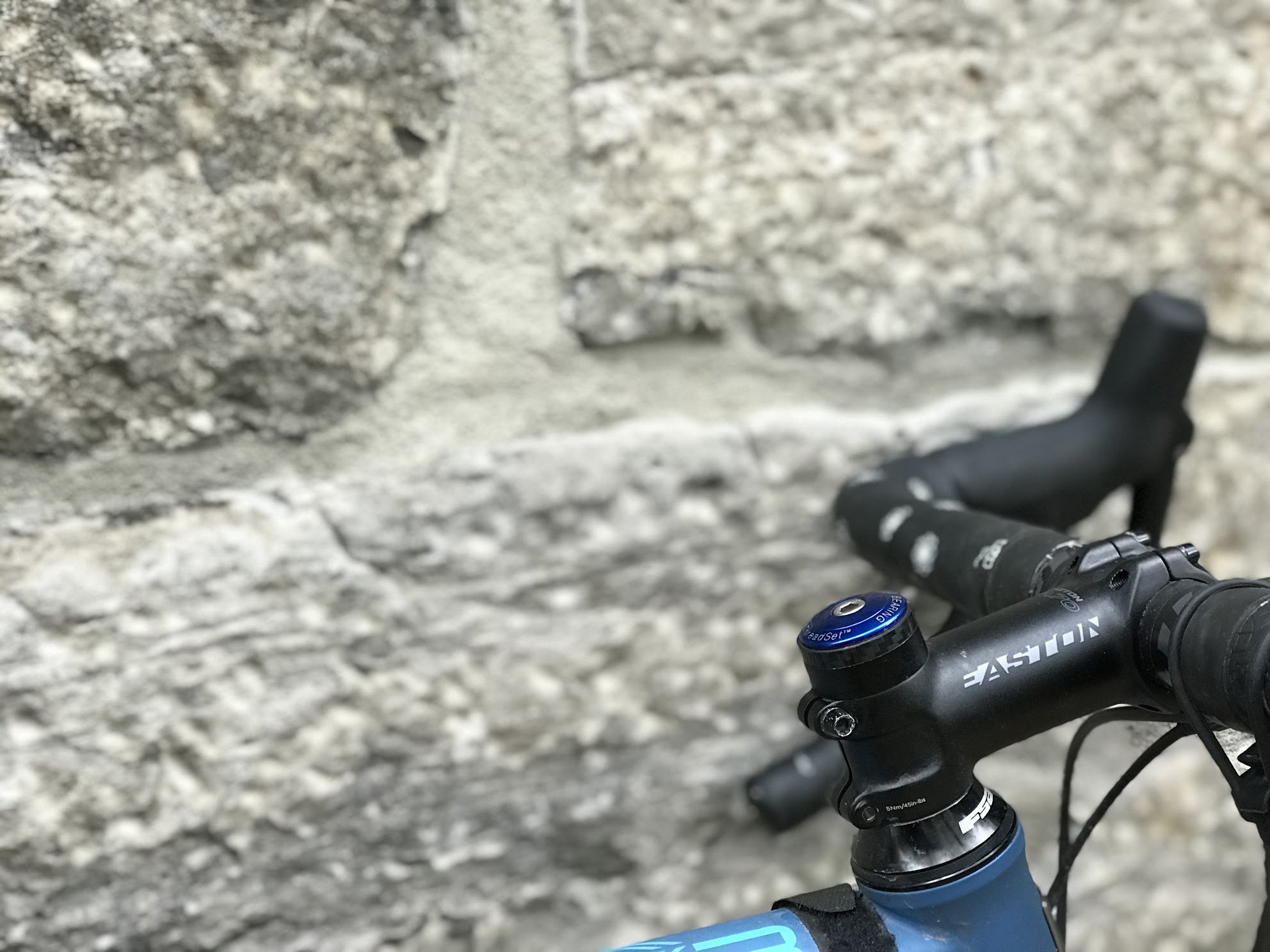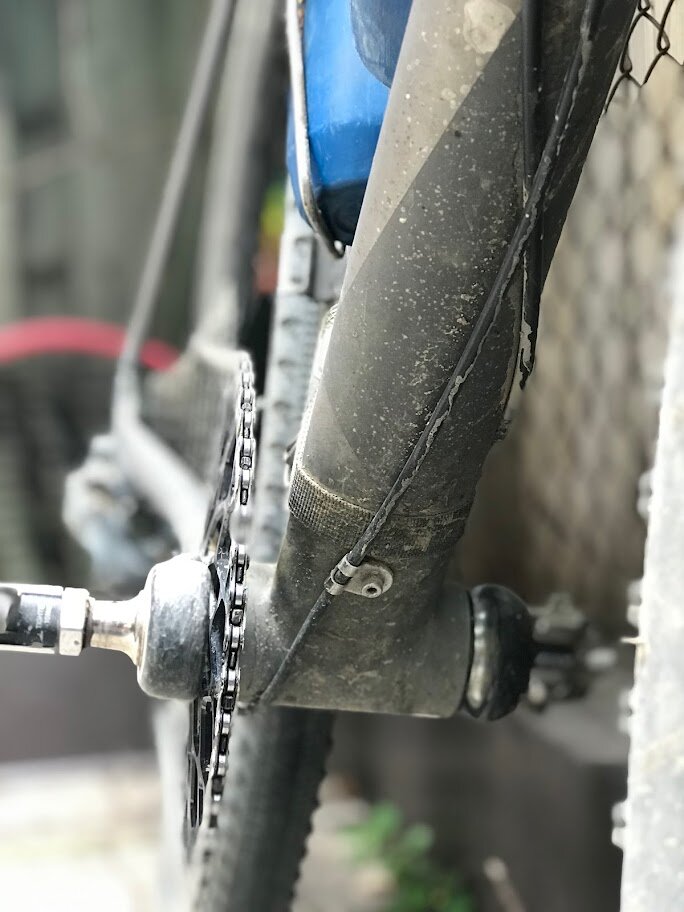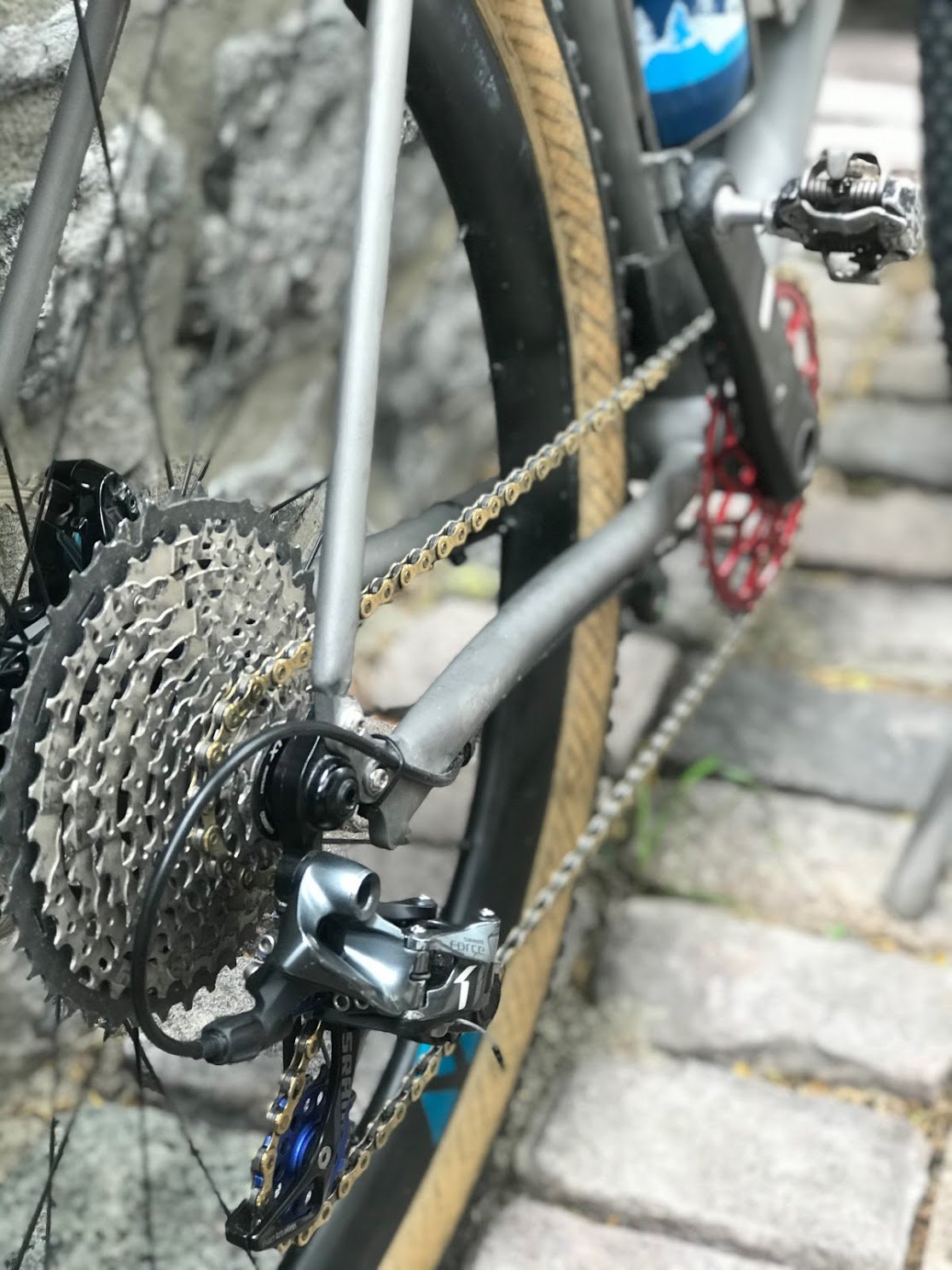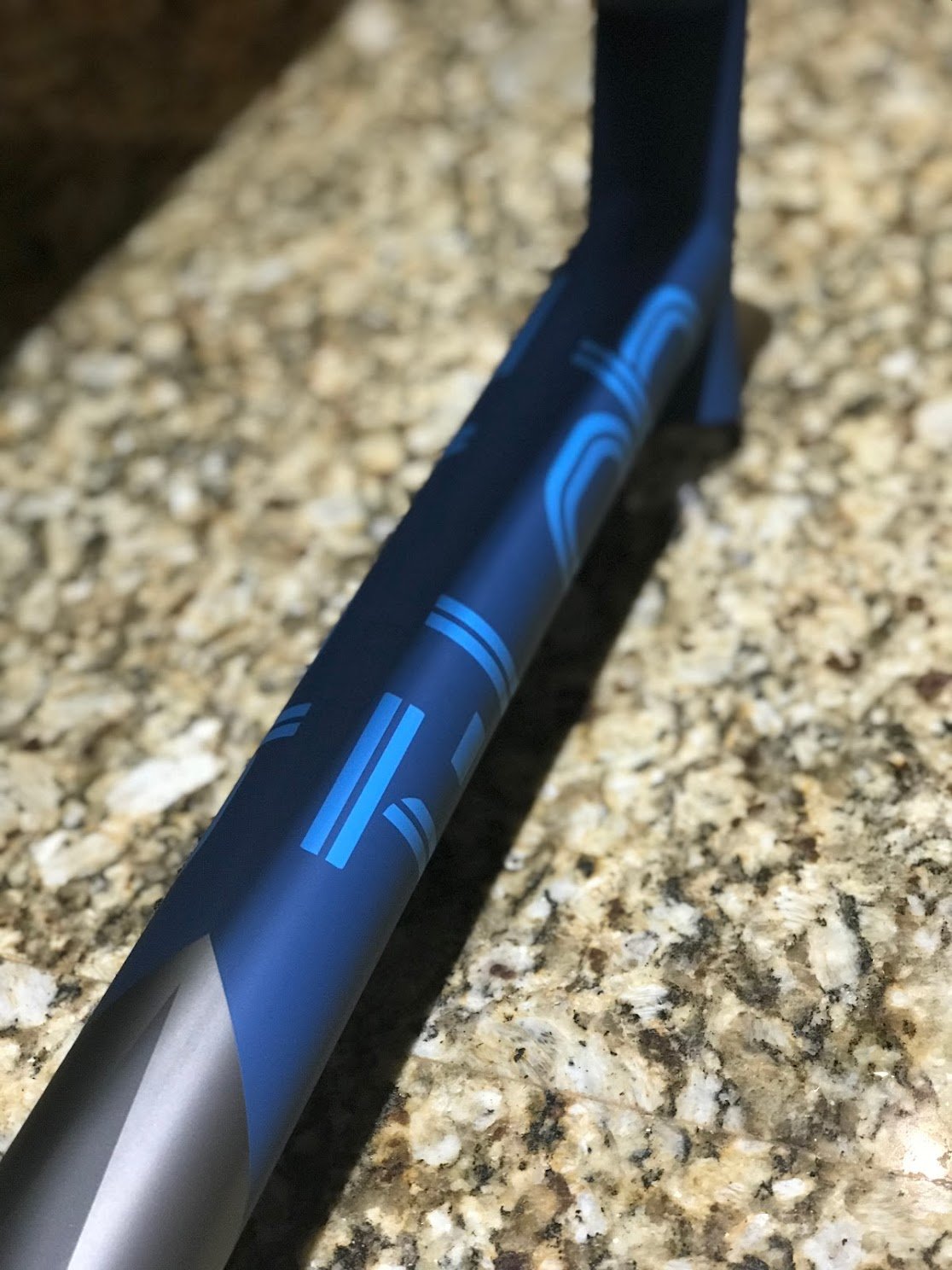Implementation: Custom T-Lab X3 #dropbarbraap
This is the final of four pieces focused on my custom T-Lab X3 gravel bike. In the first - GENESIS of a Modern Gravel Dreambike - I explain the process I went through to work out how I wanted my X3 to be different from other gravel bikes I was riding. EXECUTION: Ideas Made Material Is about the bike’s design, and how it was bound up with my component preferences. Grinduro Canada: The Mind-Body-Bike Trifecta digs into how the bike performed at the limit of ‘gravel’ riding conditions. Here, I detail the components I built the bike with.
T-Lab manufactures their frames in Montreal, Quebec, a mere 200km from my home. All their frames are constructed using seamless Grade 9 3Al - 2.5V titanium, and are available in ‘stock’ geometry, configuration, and finish at a base price ($4750 CAN frameset, $6850 GRX build), or custom geometry and finish at additional cost. T-Lab built my X3 as a fully-custom build, from my geometry to finish. I build my bike up from the frame; here’s the nitty-gritty many of you have been asking for!
Head-tube and headset - IS41/28.6 - IS52/40 (Integrated/Tapered)
The typical X3 headtube fits internal headset bearings, which I’ve had good results with on other bikes. For my build, I wanted to be able to potentially use a headset that enabled adjustable head-tube angle. Ultimately, the headset I had in mind wound up being discontinued. The team in Montreal built a very robust headtube to accommodate my request, which is considerably heavier than the stock unit. I’d be happy to go with the internal bearing spec for a next iteration of the bike.
Fork
T-Lab build the X3 with a 1.5" tapered steerer, 395 axle-to-crown, 47mm rake, 100mm thru-axle fork. Mine has threaded bosses on the sides of the legs to accommodate bike-packing stuff. The fork comfortably fits up to 650b and 700c x 48mm tires.
After primarily riding my X3 with Rene Herse Switchback Hill and Juniper Ridge 650b x 48mm tires for about a year I swapped to Columbus’s Futura Cross fork with adjustable rake. You can tap all the detail on steering geometry, 47mm versus 52mm rake, and ride quality in MATTER: Columbus Futura Cross, Adjustable Rake, and Steering Stability.
Cockpit
I designed my front-end geometry for a 90mm stem to put me into my ‘cyclocross’ body position. This position balances a range or requirements, including bunny-hopping barriers and other obstacles and descending rough and steep terrain. In contrast, an all-road bike might never ‘need’ to hop anything more challenging than a pot-hole, or navigate steep, muddy slopes.
I paired an Easton EA70 stem with their EC70 AX carbon bars in 42cm. This set-up worked well while I used the bike for all my off-road riding, but as I got back to riding on an actual MTB in 2020, I didn’t need the bike to be as #dropbarbraap as before. I swapped to an EA90 110mm stem and non-flaired and slightly more comfortable FSA bar. This yielded more of an all-road body position, which is what I needed for the bulk of tie riding I did on the bike. As discussed in Grinduro Canada: The Mind-Body-Bike Trifecta, I should have reverted to the 90mm stem for the 2021 Grinduro in Charlevoix, Quebec, but it wasn’t a big deal.
I’ve run Silca’s bar tape on the bike since day-1, which is certainly one of the nicest and most effective options available. I’ve also ridden with Road Runner’s Burrito Supreme handlebar bag for most rides, rather than stuffing my pockets. It’s taken a beating, but is still rocking. The strap over the stem us to keep if from bouncing around.
Seatpost
The frame is built to use a 27.2mm seatpost and 31.8mm clamp (included). I wasn’t sure whether I’d need the comfort of one of my Specialized C-GR carbon suspension posts (pictured), but I’d be able to position my Fizik Arione saddle where I needed it whether I used the C-GR or Easton EC90 ISA, which has zero off-set. Ultimately, I can run either post comfortably. The frame’s seat-stays are compliant/comfortable enough for the Easton ISA to be ‘invisible’ under me. There were two specific times over more than 11,000km on the bike where I needed a dropper seatpost. The most elegant way to approach this requirement would be to run a wireless option as-needed. Unfortunately, most, including me, will face a cost-barrier here.
Bottom-bracket - BB386
In order to create the tire clearance I wanted - 650b x 48mm, 700c x 42mm - the T-Lab guys went with a BB-386 shell. This shell is as wide as you’ll find for road cranks, and it accepts cups that house bearings within the shell, versus outside, like a PF BB-30, T47, or classic threaded BSA.
I went with Kogel’s ceramic bottom-bracket with CX seals, which are more protective than their road seals. This unit takes a 30mm axle, a departure from the 22mm I typically use, on Shimano and SRAM cranks. This would fit Easton’s EC90 SL crank.
Cable Routing
For a rough-and-tumble bike like my X3, I wanted maximum serviceability and reliability overall, and this bias carried over to my cable routing. Three threaded fittings were built into the underside of the downtube to accept modular cable guides. This approach avoids the necessity of disconnecting hydraulic brake line to move the system off the bike for whatever reason, and renders cable housing replacement maximally quick and easy. Full-housing for the derailleur keeps virtually all contamination out, even when washing the bike vigorously. The key to smooth and precise mechanical shifting is replacing cable and housing regularly. For me, once a season is often enough with full-length housing. My set-up ‘encourages’ this maintenance, while internal routing on many bikes ‘discourages’ it. This matters more for home-mechanics like me than those who have shops do their bike work.
The modular set-up also provides flexibility to add routing for a third line. This could be for a front derailleur or dropper post, but I wouldn’t do both at the same time (this would be a mismatch). For a front derailleur, the upper two guides would be swapped to accommodate three lines, while a guide would be mounted to the bottom to route the rear derailleur and brake lines, with a housing stop for the front derailleur line in the middle. This would send cable out and under the bottom-bracket shell, through a guide, and up to the front derailleur. The Campestral MOD.GUIDE would work, by stacking the cable stop over their housing guide. I seem to have lost track of the 1-piece guide that incorporates two lines and one cable-stop; let me know if you can point me toward one!
In the event I choose to run a dropper post, it would have to be externally cabled or wireless. For the former, I could swap each guide to one that accommodates three lines, like this one from Paragon Machine Works. I’d have to zip-tie the line up the seat-tube.
Drivetrain
The bike initially came together with an Easton EC90 SL crank (30mm axle. 172.5mm), Absolute Black oval direct-mount ring, SRAM Force 10-speed X0 MTB derailleur with Kogel alloy pulleys rolling on ceramic bearings, Shimano 11-34 cassette, and KMC chain.
As time passed I morphed the set-up into more trail-friendly gearing, using a Shimano XT 11-42 cassette, SRAM Force 1 derailleur with Kogel pulleys, and AB rings ranging from 38t to 46t. I used axle adapters to use a SRAM Force crank with 24mm axle; this opened up more ring options, since I’ve been using this crank for years and have amassed numerous sizes. For racing, the 11-42 cassette has annoying gaps between small cogs, but through the pandemic that didn’t pose an issue. T-Lab welded on a front derailleur tab to future-proof the bike, given its seat-tube isn’t round where you’d want to clamp a derailleur on. If I wanted to race this bike on flat terrain with the 1x11 SRAM drivetrain, I’d be fine with a 44 or 46t ring and 11-32 or 11-34 cassette. It’s the more hilly and mountainous terrain that can push doubles into their own, along with Campagnolo’s EKAR group. I’d hoped to mount EKAR for 2021, but the pandemic interfered. EKAR’s 1x13 gearing has 1-tooth steps between each of the smallest 6 cogs, which solves the problem of 2-tooth jumps interfering with efficient cadence while racing in groups.
Kogel’s pulleys are particularly effective on a 1X drivetrain like this, given the derailleur’s clutch and static tension on the chain introduce more drag (wasted energy) into the system than 2X derailleurs. Yes, shifting precision tends to feel a little more crisp and precise than with stock plastic pulleys, but the drag benefits are more to do with Kogel’s ceramic bearings, which bleed away less energy than stock bearings or bushings (lower-lever derailleurs use bushings). As chain tension increases, this benefit increases, and their CX seals do a fantastic job keeping contamination out. The lower pulley of the SRAM 1x11 set bumps tooth-count from 12 to 14. The increased pulley diameter further reduces chain drag as it runs through the tensioned pulley.
I’ve run this drivetrain primarily with Absolute Black’s compatible lubes. Their GRAPHENwax is applied like other immersion waxes, while their GRAPHENlube is an emulsion lube, applied via immersion in a bag for maximum penetration, or on the bike like other lubes. Wax is ‘dry’, and runs fairly ‘clean.’ The drip-lube can be used relatively sparingly for a VERY clean drivetrain that doesn’t ‘attract’ contamination. I’ve seen extended chain life using these lubes, and rather minimal wear to my chainrings, pulleys, and cassettes.
Shift levers went from SRAM Apex to Force after I sold off one of my CX bikes. The Apex shifter suffered bizarre indexing issues I was never able to work out, which seems to have been related to quality control issues they experienced. I’d thought it made sense to run the aluminum lever bladed Apex rather than my carbon-bladed Force, for durability reasons, but I’ve actually never had issue with broken HRD carbon lever blades breaking. A carbon shift lever has broken, however. Overall, Force has provided consistent shift quality, and overhauling their assemblies for maintenance is relatively easy.
Brakes
Once upon a time, SRAM’s HRD mechanical shifting / hydraulic disc brake system was the best option available for 1X drivetrains. Shimano didn’t even have a 1X system, so there wasn’t actually any competition. Running this system on 4 bikes, two being matching CX race bikes, has afforded me thousands of hours on the system, and easily more than 50 hours working on them.
Brakes / braking is the Achilles heel for drop-bar bikes configured for off-road riding. In order for my #dropbarbraap bike to really ‘work’ as intended, I needed my brakes to provide power with one finger from the hoods similar to an XC mountain bike. I’ve always built my drop-bar disc bikes with 160mm rotors (larger of two options), and since they’ve always had smaller and less grippy tires, no suspension, and are lighter than my MTBs, they should theoretically need less sheer brake power to lock up.
On rough and especially steep terrain, holding onto the hoods with three fingers is necessary, which leaves the index finger to cover braking. The index finger applies pressure near the top of the brake lever-blade, where it has the LEAST leverage over the master cylinder push-rod. The bottom of the lever blade generates the MOST leverage, but is out of reach, and ‘rolling’ the hands forward to drop the index finger lower renders hands more prone to being jolted forward and off the hoods when the front wheel smashes obstacles. DANGER!
Why not ride the steepest, gnarliest terrain from the drops? The drops do indeed provide the greatest security for the hands, and strongest braking. However, they also place the hands in the lowest position possible, which is opposite what we want for tackling steep, rough terrain. Instead of positioning the body’s centre of mass down and toward the rear axle, it moves forward and down toward the front axle. The longer reach to the drops also reduces the arms range of motion (elbow articulation). To keep the centre of mass low and rear-biased, the arms have to be fully extended, which virtually eliminates the ability to manipulate the front wheel vertically, and reduces front brake traction massively.
The only way to make drops work remotely well on technical terrain is with a dropper post, which allows the centre of mass to lower in proportion to the hands (hopefully), and thus ‘break-even’. This added vertical room also increases the legs’ range of motion, which translates into ‘suspension’ and increased ability to push the bike into the ground. Alternatively, one can position the bars higher in the first place, but this diminishes some of the actual benefits of drop bars for a gravel bike. Fun Fact: Matej Mohorič used a dropper post to increase his descending control and speed at the 2022 edition of Milan - San Remo; he won.
Riding the hoods, especially those as tall as SRAM HRDs, can actually work really well for terrain that’s as gnarly as makes sense to ride on tires that also make sense to ride on a drop-bar bike. However, this only works well enough when braking power is at its maximum potential.
I worked hard to get my SRAM brakes to operate well enough with one finger to render my overall set-up effective. I had most success with Swiss Stop’s RC (race) compound brake pads, and their Catalyst rotors and Shimano XTR rotors. This set-up worked well while my brakes were still fairly new, but all 4 of my systems degraded in various ways, always at the lever. I’ve experienced broken bushings inside the push-rod assemblies, damaged and swollen o-rings. The push-rode assembly in these brake levers is their weak link, and spare parts are not readily available in Canada. The wear parts are bushings and o-rings, but SRAM only sells the whole assembly, which includes the aluminum push-rod, which is not a wear-part, and is certainly far more expensive than the other bits. They use split bushings, which break into pieces. Any damage within this assembly affects caliper piston travel and brake power. Upgrading to something like a Hope X4 caliper wouldn’t make a difference while braking problems originate at the lever, and I’ve noted that many, if not all my friends who run the same system tend to think their caliper pistons are the issue when they get floppy levers and braking suffers. The lever is almost always the issue. Knowing these brakes are difficult to keep working well was a factor in my decision to run simple external cable routing, and not routing my front brake line through my fork.
Overall, while my brakes were operating in a ‘normal’ state of repair, power and modulation was acceptable. Cyclocross wasn’t and generally won’t be the most demanding context for hard braking performance, but is more about consistent and predictable power across a broad range of conditions and pad wear-rates. The most demanding context for brakes is steep terrain that requires near constant braking for extended periods of time. I’ve experienced only a little of this locally, on a trail called ‘Monique’s,’ which is on the technical end of the MTB spectrum. I’ve ridden it a couple times on the X3, prior building my Trek Stache, and the hard, frequent braking was very hard on my hands. This sort of riding isn’t a good fit for a drop-bar bike in the first place, but is more of an outlier. Within the span of ‘gravel events’ I’ve done, the Quebec Grinduro in Charlevoix pushed my brakes more than anywhere else, since its descents were steep and rough at times, and steep and switchbacked at other times. I’d prefer to use a hardtail MTB for both these applications, and I don’t think it’s a problem that the HRDs lack heat management and power matched to these demands. My greater concern is reliability and consistency, especially when riding paved alpine descents, where repeated heavy braking is required for switchback turns. That sort of riding can be done safely from the drops, tapping full leverage and enabling strong front tire grip. Brake hard while pointed straight, release front brake before initiating the turn, and trail brake the rear as needed.
Shimano improved the lever leverage issue with their GRX series, but in the mechanical format they continue to expose shift internals to the elements, and I DO NOT like brake lever blades moving across two axes (i.e., swinging in to shift). Electronic systems are better in this regard, but out of step with my use-case for this bike.
Campagnolo’s EKAR group presents improvements to both gearing and braking, from all indications. Mechanical, 13 speed, and featuring heralded braking, I’m optimistic EKAR is a step forward. I hope to acquire a group and begin riding it in 2022.
Wheels & Tires
The T-Lab team built my X3 to fit tires up to 700c x 45mm and 650b x 51mm. I ride Woven Precision Handbuilt carbon wheels on virtually all my bikes, and was primarily keen to ride 650s on the X3. Built with Sapim CX-Ray spokes, my wheels are stiff and responsive, leaving compliance to my tires, frame, seat-post, and fork.
I’ve spent the majority of my time on the bike rolling on two sets of 650s - one in the older narrower width, the other the ‘gravel’ wider version - with 48mm Rene Herse tires. The Switchback Hills in Extralight casings, tubeless, are my all-rounder set-up, while their Juniper Ridge knobbies feel great for ‘trail-mix’ rides, which blend all surfaces, including trails on the non-technical end of the off-road spectrum. These tires are the most supple out there, so for sharp, rocky terrain I’ve also used Terrene Elwoods front and rear, and Panaracer’s Gravel King SK, which is a better front tire than rear (too slow-rolling under load). My go-to combo for the most abusive riding I’ve done on the bike has been the Tough casing Elwood on the rear, and Panaracer up front. The fastest and most ‘inspiring’ set-up I’ve ridden with knobs remains the Juniper Ridges in Extralight casing (tubeless).
With the bike’s original 47mm rake fork, it didn’t really make sense to use high volume 700c tires; the steering geometry doesn’t work well beyond 35mm. This has never been a problem, since the bike’s original body position and gearing was not suited to the sort of riding that aligns with larger 700c tires. Meaning, if I wanted to do a 250k paved/dirt-road ride I wouldn’t want to be in my CX body position, nor would I likely want my 1X gearing. So putting 700c x 42mm tires on the bike for steady-fast rolling wouldn’t align with the rest of the bike’s set-up. Yes, the frame is really comfortable, but there’s more to it than that: while the bike’s position and gearing was ‘trail-biased,’ 650b tires made sense, and it all worked well. That trail set-up translated well to cyclocross, so converting the bike for CX racing was simple. I mounted 700c x 33mm CX tires, and let it rip. As hoped, the bike rode really well in that configuration, and outperformed my Brodie Romax in the muddy conditions I designed the geometry to excel at.
Installing the Columbus Futura Cross fork allowed me to experiment with more 700c tires in the 52mm rake setting, extending beyond what the original geometry could handle well. To harmonize with a broader range of tire setups, I lengthened my position by 20mm, and installed a larger chainring. This rendered the bike more ‘fast-gravel’ in character than prior, which worked well. I used this setup for some winter riding, along with the stock fork, which works best with 700c x 33-35mm tires with very fine tread (file treads). With either fork rake setting, the bike is more stable on snirt than any of my other bikes with steeper head tube angles and shorter top-tubes have been (apples to apples, I’ve used the same wheels and tires on those bikes).
Detailing
#dropbarbraap captures the character of my X3. It’s biased toward the gnarliest end of the gravel spectrum, the rougher and steeper the ride gets, the more the bike excels. My X3 feels a lot more like a mountain bike while brappin’ than other dropbar bikes with big tires meant to emulate the feel and handling of road bikes. The nice thing about my X3 is that it can be adapted to ride really well in all-road applications, while the opposite isn’t true: all-road bikes can’t feel as stable and confidence-inspiring as my X3 on technical terrain. As built, and with the updated benefits of the adjustable-rake Columbus fork, I can adapt my X3 to perform well across a broad spectrum of mixed-surface riding.
Designing and building out a bike for maximum versatility is challenging, and will often carry compromises. For example, my front derailleur tab adds a little weight and aero drag. It’s a minor thing that doesn’t bother me. If I’d wanted to create the most seamlessly polyvalent version of my X3, I’d have sold off another bike to finance SRAM AXS components. The wireless system enables addition of a front derailleur without messing with bar tape, cable and housing. The AXS dropper post is the same; it can be mounted in seconds. SRAM and Easton cranks, being modular, afford the simplicity of swapping between double rings mounted to a spider and direct-mount ring in minutes, and chains can also be swapped to maintain proper length in seconds. Thus, to convert from a very trail-biased bike set-up to the far end of the all-road spectrum, all that remains is to swap wheels/tires (with appropriate cassette), and stem length. Installing and adjusting a front derailleur is fiddly, and it’s not wise to swap stems often (carbon steerers and bars require great care wrt torque), but these are the two most ‘technical’ changes to undertake in order to convert my X3 from 1X dropgnar format to full-on all-road, suitable for riding up and down mountains. The downside to this maximal polyvalence, of course, is reliability, which is where I have less faith in electronic systems. ‘Faith’ says it all, really; I’m more about trust, which is earned through demonstration of reliability in real-world conditions.
There is no ‘perfect’ solution when we’re aiming for maximal versatility and ease of conversion. My X3 set-up reflects my priorities, and I have other bikes for other slices of my riding requirements. If I had one drop-bar bike, my priorities would shift, as would by cost-benefit analyses.
Specifications
Headtube: IS41/28.6 - IS52/40 (Integrated/Tapered) - FSA headset
Fork: 1.5" tapered steerer, 395 axle-to-crown, 47mm rake, T-Lab 100 x 12mm thru-axle / Columbus Futura Cross, 47/52 rake
Handlebars: Easton EC70 AX 42cm, FSA Wingbar 44cm
Stem: Easton EA70 90mm, EA90 110mm
Griptape: Silca
Handlebar Bag: RoadRunner Burrito Supreme
Head Unit: Garmin 520+, K-Edge mount
Rear Light: Garmin Varia
Seatpost: 27.2mm, 31.8mm seat clamp - Specialized CG-R, Easton EC90 ISA
Seat-collar: T-Lab aluminum
Shift/brake Levers: SRAM Apex 11sp
Front Derailleur: Braze-on type
Rear Derailleur: SRAM Force 1, Kogel 12/14T ceramic-bearing alloy pulleys with CX seals
Cable Routing: External modular (bolt-on guides) - Jagwire housing and stainless cable
Brake Pads: Swiss Stop RC, Kogel Kratos
Rotors: 160mm Swiss Stop Catalyst, Shimano XT, XTR
Bottom Bracket: BB-386 - Kogel Ceramic with CX seals
Crank: Easton EC90SL, EA70, SRAM Force (172.5mm)
Chainring: Absolute Black Premium Oval Direct-mount (38-46t)
Chain: Shimano Ultegra, KMC SL
Cassette: Shimano Ultegra 11-32, 11-34, XT 11-42
Pedals: Shimano XT
Dropouts: Modular aluminum, T-Lab 142 x 12mm thru-axle, flat mount disc
Wheels: 700c or 650B - Woven Precision Handbuilts with Sapim CX-Ray spokes
Tires: Max widths: 700x45c or 650Bx51 - Rene Herse Bon Jons (700c x 35mm), Switchback Hill and Juniper Ridge (650b x 48mm), Stan’s tubeless sealant
Bottle Cages: Stainless steel
Pump: Silca Impero
FInishing Bling: Chris King headset cap, Kogel Ti stem and water-bottle bolts
Questions?
Have I covered all the build details you’re looking for? Let me know!


